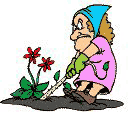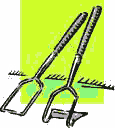
The Art of Weeding: Part 2
A year-round strategy for organic weed control
By Marion Owen, Fearless Weeder
for PlanTea, Inc. and
Co-author of Chicken Soup for the Gardener's Soul
FEATURE ARTICLE:

Tom Hanks' "Power of Four" solution
More good stuff:
Who is Marion Owen?
FAQs about PlanTea
Search Marion's articles, tips and recipes
Why grow organic?
News and press releases
Read love letters
How to link to this site
Need a speaker?
How to contact Marion
Visiting Alaska?
Come to Kodiak Island!
Go to home page

Marion's UpBeet Gardener
Newsletter has been
replaced by Marion's blog
which you can find at:
www.marionowen.wordpress.com
 In
Part One of this series on organic
weed control we learned about how weeds affect our garden and tips to
prevent them in the first place. In this article, we'll learn how to get
rid of weeds, naturally, tools for the job and how weeds can even be good
for you and your garden.
In
Part One of this series on organic
weed control we learned about how weeds affect our garden and tips to
prevent them in the first place. In this article, we'll learn how to get
rid of weeds, naturally, tools for the job and how weeds can even be good
for you and your garden.
Real tips for getting rid of weeds
As the saying goes, the bigger the elephant, the harder it is to move it. In the garden, the bigger the weeds, the harder it is to control them. The first step to controlling weedis to get into the habit of going on patrol in your garden. It sounds so basic and simple, yet it's one of the best ways to really get to know what's going on in your garden.
The
best--and worst--times to weed
Some gardeners prefer to pull weeds early in the morning while the soil
is still damp with dew and after they've had a cup of coffee. Others find
that weeding after a day at the office is a wonderful way to de-stress.
After a good rain makes the job easier, too. Of course, avoid hailstorms,
blizzards, floods and lightning storms--the weeds can wait!
Develop
your own strategy
Let's say you return from vacation only to find the garden overrun with
strange plants. Don't throw in the trowel. Start in one area and work
a little at a time. Set a goal for yourself. For example, "I'll weed from
the maple tree to the edge of the porch." One trick you might try is to
set your timer for an hour and then quit.

Still overwhelmed? Consider bringing in reinforcements such as the neighborhood kids looking for summer spending money. Be sure to show them which plants are weeds and are keepers!
Dry
soil vs. damp soil
You only have to try pulling weeds once from dry, compact soil to know
that it it's hard work. Moisten the ground or wait until after a good
rain shower before tackling weeds. (Tip: Be careful to not transfer diseases,
such as rust, to other plants during particularly wet periods.)
Small
is beautiful
 Younger weeds are easier to pull because they haven't established a strong
root system. Cultivate small weeds by gently stirring the soil's surface
to uproot newly germinated weeds before they become a problem.
Younger weeds are easier to pull because they haven't established a strong
root system. Cultivate small weeds by gently stirring the soil's surface
to uproot newly germinated weeds before they become a problem.
For an area with many shallow-rooted, small weeds, simply rake the area and leave the uprooted weeds to die. "That minimum effort," says Eliot Coleman, author of the book, Four-Season Harvest, "yields a maximum benefit, curing the weed problem, while making a tidy garden. And like a clean bedroom may motivate a teenager to spend more time keeping it clean, a tidy garden may motivate you to spend more caretaking time there.
Don't
dig too deep
Plowing or deep tilling buries weed seeds, and then brings them back up.
In other words, let buried seeds stay buried. Most weed seeds germinate
only in the top 2 inches of soil.

Studies show that rototilling and
other deep tilling methods
do more harm than good by breaking down the soil structure and
bringing weed seeds to the surface to germinate.
Kill
'em with kindness
One year, I decided to cover the paths around my raised beds with sawdust.
I called the local sawmill and ordered a truckload of spruce sawdust.
Little did I know that the tiny wood shavings were loaded with horsetail
spores!
For several years, I pulled and yanked out horsetail plants. Through the
experience I developed an appreciation for why this is one of the earth's
oldest plants! I also learned that horsetail, like many weeds, prefer
marginal, nutrient-poor soil. Thus, the more I raised the pH and improved
the quality of the soil by applying organic mulches and compost, the less
I had to deal with such weeds. Killing them with kindness works!
Tools of the weedy trade
Do
the hoe down—dance with your hoe!
Cultivating with a hoe is one of the best ways to prevent weeds. Eliot
Coleman says, "Cultivation deals with weeds before they become
a problem. Weeding deals with the problem after it has occurred."
In other words, hoe, hoe, hoe to make them go!

There are a number of hoes on the market that make short order of the task. As I mentioned before, the secret is to hoe the weeds before they declare themselves, or very soon afterwards. It take little time to whip over a pretty bare piece of ground with a hoe, but a long time to hack through ground heavily infested with weeds.
For cultivating, an effective hoe need to be:
- Sharp -- Allows you to work shallowly and not disturb the roots of the keeper plants
- Angled -- For drawing, not choppin
- Slim -- So as not to push soil onto plants
- Accurate -- So the hoe passes between rows or plantings without damage comfortable (consider handle length, grip, etc.)
- Fun to use -- Otherwise, you'll find other ways to spend your time. Consider painting a bright color!
Coleman, whose favorite weeding tool is a collineal hoe, suggests going
out on a summer's evening, put a Strass waltz on the stereo and dance
with your hoe. "Weed control has never been so civilized."

Do the Weeding Waltz!
More cool tool tips
- In an open, unmulched area, the tool of choice is a scuffle or stirrup hoe, which you push and pull across the ground to sever the weeds below ground level. The harder you push, the deeper it goes. Be sure to sharpen the blades periodically with a file.

A scuffle or stirrup hoe.
- For weeds in and around other plants, a small hand rake or hand cultivator is the best tool, or simply pull them out by hand.
- For weeds in hard-to-reach areas, use a four-pronged cultivator, whose narrow width is ideal for getting around cramped spots.

- For weeds with long taproots, like Queen Anne's lace and dandelions,
use a gardening knife or a tool with a small V-shaped end to loosen
the soil around the roots. Then gently pull up using the tool to apply
a little pressure on either side of the stem. (For more about dandelions,
see my article, Seven Ways to Get Rid of Dandelions--Without
Chemicals).
- For weeds that grow up through plants, loosen the roots with a screwdriver
or similar tool before pulling them up by hand.
- For weeds growing between cracks in pavement, walkways or decks try
pouring boiling water or vinegar over them. You made need to repeat
the treatment, but it does work. You can also use a weeding blade, which
is a thin blade with 90 degree bend and sharp edge for cutting between
stones, bricks, and so on. Thes eare available with short and long handles.
- For stubborn, large weeds, use a mattock to pry them up.
|
- - -
- - - - - - - - - - - - - - - - - |
At the end of the growing season
- Weed after you harvest. At the end of the season, most plants (including
weeds) rush to make seeds. After pulling plants, wait a week or two
and cultivate the surface of the soil to eliminate newcomers.
- Put a 2 to 3-inch layer of mulch or compost to protect soil from the
elements and suppress weed seeds. For my articles about composting and
other organic gardening tips, click here.
- Plant a cover crop. Also known as green manure, cover crops are a natural way to replenish the nutrients in your garden soil. After the fall harvest, cultivate the soil and seed a cover crop of a low-growing grass or legume crop. Cover crops also fix the nitrogen in the soil, add organic matter and help suppress weeds over the winter. Sources for cover crop seeds: Johnny's Selected Seeds and Territorial Seeds.
|
- - -
- - - - - - - - - - - - - - - - - |
Not all weeds are bad
When weeds seem overwhelming and your aching back says it never wants to see another wheelbarrow of mulch, think of the good side of weeds:
- Weeds produce quick cover for land devastated by fire, flood or construction.
- Weedy areas provide a haven and a food source for many of the beneficial insects that prey on garden pests.

- Songbirds and other wildlife depend on weed seeds as a food source.
- Many weeds are a valuable source of medicines and dyes. There's a
smorgasbord out there, growing for free. Purslane, lamb's quarters,
dandelion greens, chickweed and watercress are loaded with vitamin C,
beta-carotenes and more. As for dyes, ragweed produces a green color;
dock, yellow.
- Dried flowers, seed pods and stems of many weed--especially weedy grasses--make attractive dried bouquets and materials for craft projects.
Weedy words of encouragement
Don't go overboard trying to eradicate every last weed. After all, some weeds are just plain pretty! From gardenforever.com, a very inspirational gardening site:"Try to relax about the weeds. A few weeds won't destroy your garden. It's amazing what you can live with."
|
- - -
- - - - - - - - - - - - - - - - - |
Thanks for visiting and please stop by again. I'll put the coffee on!
Meet Marion Owen /// Learn about PlanTea /// Online Catalog /// Articles, Tips, Recipes /// Get free UpBeet Gardener newsletter /// Read current issue /// Listen to radio show /// Read news and press releases /// More resources and links /// Learn why 'grow organic?' /// View guidelines for retailers /// Read love letters /// Book Marion as a speaker /// Site map /// How to link to us /// Contact us /// Go to home page
PlanTea: The organic plant food in tea bags. http://www.plantea.com
Copyright ©1996 to present: PlanTea, Inc. All Rights Reserved. PO Box 1980, Kodiak, AK 99615-1980 USA
Questions or comments? marion@plantea.com Phone: Toll Free: 1-800-253-6331 (US and Canada); 907-486-2500